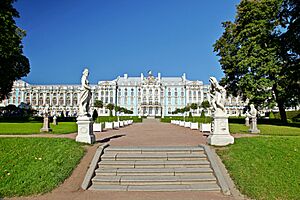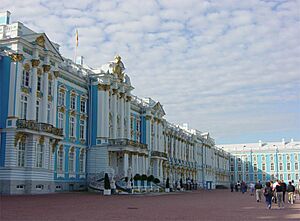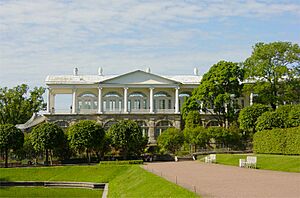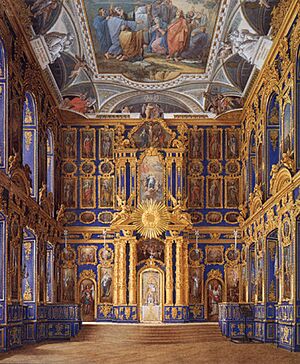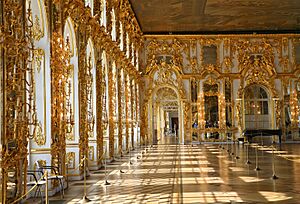Catherine Palace facts for kids
The Catherine Palace is a beautiful palace in Tsarskoye Selo (now called Pushkin), Russia. It is about 30 kilometers south of St. Petersburg. This palace was once the summer home for the Russian emperors and empresses. It is also part of a special World Heritage Site that includes many historic places in St. Petersburg. The palace is famous for its fancy Rococo style, which is a very decorative and elegant way of building and decorating.
Contents
History of the Catherine Palace
Early Beginnings and Catherine I
After a big war called the Great Northern War, Russia got back a farm area known as Saari Mojs. In 1710, Peter the Great, the Russian emperor, gave this land to his wife, Catherine I. The village there was first called Sarskoye Selo, and later became Tsarskoye Selo, meaning "Tsar's Village."
In 1723, Catherine I had a stone palace built to replace an older wooden house. This first palace had two floors and sixteen rooms. Some rooms were decorated with shiny alabaster, and one even had special tapestries. There was also a lovely garden with terraces and ponds, and a place for animals on the other side of the estate.
Empress Elizabeth's Grand Vision
When Peter the Great's daughter, Empress Elizabeth, became empress, she wanted an even grander palace. Work on a new design started in 1744. The palace was made much bigger, reaching 300 meters long. It included a main house, two side wings, a chapel, and a conservatory hall. These parts were all connected by galleries with hanging gardens.
In 1751, a famous architect named Bartolomeo Rastrelli took over the project. He made the palace look truly amazing with its bright white columns, sky-blue walls, and lots of gold decorations. He used almost 100 kilograms of gold! Rastrelli's designs were in the Baroque style, which is known for being very grand and dramatic. Famous artists helped create the sculptures, gold decorations, and paintings inside. Some special rooms included the Chinese Room with its beautiful porcelain, the Portrait Hall, and the famous Amber Room, which had walls covered in amber panels. The palace was finished in 1756, with 40 grand rooms and over 100 private rooms. New gardens and pavilions were also added.
Catherine the Great's Changes
In the 1770s, the palace's style changed from Baroque to Neoclassical. This happened when Catherine the Great used Tsarskoye Selo as her summer home. Architects like Yuri Velten and Charles Cameron updated the palace. The main staircase was replaced with new state rooms, and a new staircase was built.
Cameron's designs in the 1780s included rooms like the Arabesque Room, with its painted ceilings and walls, and the Lyons Room, which had golden-yellow silk on the walls and special blue stone on the doors. The empress's bedroom featured beautiful carvings. Other rooms, like the Blue Room, used white and blue glass. Later, Giacomo Quarenghi designed the Mirror and Silver Rooms in 1789. Many new buildings and monuments were also added to the park during this time, including the Chinese Village and the Alexander Palace.
Later Years and Restoration
After Catherine the Great passed away in 1796, new construction in the park slowed down. Over the years, parts of the palace were restored after a fire in 1820 and other changes were made.
Sadly, during World War II, when German forces left after the siege of Leningrad, they deliberately destroyed the palace. Only the empty shell of the building remained. However, Soviet experts had carefully recorded many details of the palace's interior before the war. This was incredibly important for rebuilding the palace. Reconstruction began in 1957, bringing the Catherine Palace back to its former glory.
Layout of the Palace
While some parts of the palace show the styles of the late 1700s and early 1800s, the Catherine Palace is most famous for Rastrelli's amazing series of formal rooms, known as the Golden Enfilade. An "enfilade" means a line of rooms that are connected, so you can see through them all.
The Grand Hall
The Grand Hall, also called the "Hall of Lights," is a huge and airy ballroom. It has a spectacular painted ceiling. This room was designed by Bartolomeo Rastrelli between 1752 and 1756. It was used for important events like balls, fancy dinners, and masquerade parties. The hall is painted in two colors and covers about 1,000 square meters. Windows on one side look out onto the park, and windows on the other side face the palace plaza. In the evening, nearly 700 lamps light up the hall from chandeliers near the mirrors. The beautiful sculptures and gold decorations were made following Rastrelli's designs.
Dining Rooms
Beyond the Grand Hall is the Courtiers-in-Attendance Dining Room. This smaller room was also designed by Rastrelli. It has real windows looking out to the courtyard, and false windows with mirrors on the opposite wall to make the room seem bigger and brighter. It's decorated in the fancy Baroque style with lots of gold carvings and patterns of flowers. The ceiling painting shows a scene from Greek mythology with the sun god Helios.
Across from this room is the White Formal Dining Room. This hall was used for the empresses' special dinners. Its walls are covered in very rich gold carvings. Some of the furniture in this room is original, while other pieces are copies. The ceiling painting, The Triumph of Apollo, is a copy of a 16th-century Italian artwork.
Portrait Hall and Other Rooms
The Portrait Hall is a formal room covering 100 square meters. Its walls display large portraits of Empress Catherine I and Empress Elizabeth Petrovna, as well as other important figures like Empress Catherine the Great. The floors are made of beautiful, expensive woods.
The Drawing Room of Alexander I was part of the emperor's private area. It was special because its walls were covered in Chinese silk. Other decorations included a painted ceiling and gold carvings. Elegant card tables and wooden cabinets display beautiful porcelain from Japan, China, and Berlin.
The Green Dining Room, designed by Cameron, is in the northern part of the palace. Its pistachio-colored walls have stucco figures. This room was badly damaged in a fire in 1820 but was later restored.
Other rooms designed by Cameron include the Waiters' Room, with its fancy wooden floor and stylish card tables; the Blue Formal Dining-Room, with white and blue silk wallpaper; and the Chinese Blue Drawing Room, which mixes different styles.
Images for kids
See also
 In Spanish: Palacio de Catalina para niños
In Spanish: Palacio de Catalina para niños
- List of Baroque residences


